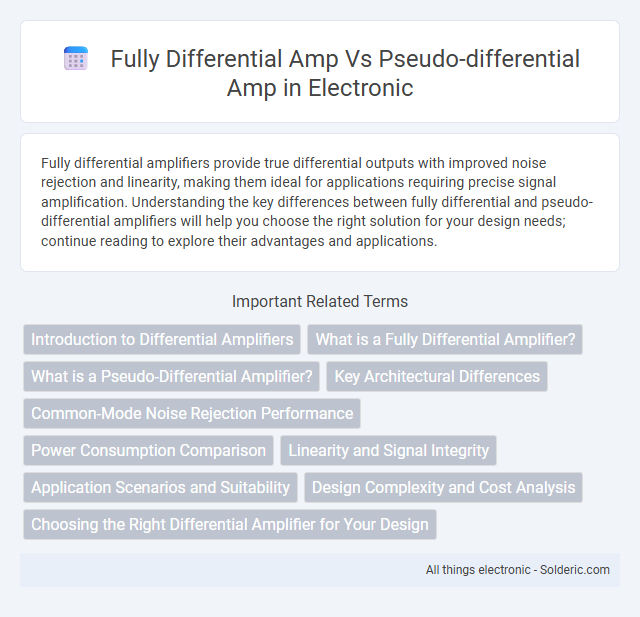Fully differential amplifiers provide true differential outputs with improved noise rejection and linearity, making them ideal for applications requiring precise signal amplification. Understanding the key differences between fully differential and pseudo-differential amplifiers will help you choose the right solution for your design needs; continue reading to explore their advantages and applications.
Comparison Table
| Feature | Fully Differential Amplifier | Pseudo-Differential Amplifier |
|---|---|---|
| Signal Type | Processes fully differential signals (both inputs and outputs differential) | Processes differential inputs but single-ended output |
| Output | Two outputs with opposite polarities | One single-ended output |
| Common-Mode Rejection Ratio (CMRR) | High CMRR due to symmetric design | Moderate CMRR, less effective at suppressing common-mode noise |
| Power Consumption | Higher power consumption due to differential output stages | Lower power consumption |
| Application | High-precision analog signal processing, ADC front-ends, instrumentation | Intermediate stages, lower-cost amplification with some differential input benefits |
| Complexity | More complex circuit design and layout | Simpler design and implementation |
| Noise Performance | Better noise rejection due to full differential architecture | Less noise immunity compared to fully differential amps |
Introduction to Differential Amplifiers
Fully differential amplifiers provide true differential gain with both positive and negative outputs, improving noise rejection and linearity in analog signal processing. Pseudo-differential amplifiers, while offering some common-mode noise rejection, rely on a single-ended output and lack the balanced output stage of fully differential designs. This distinction is critical for high-performance applications requiring precise signal integrity and minimized distortion.
What is a Fully Differential Amplifier?
A fully differential amplifier processes two complementary input signals and produces two output signals that are equal in magnitude but opposite in phase, enhancing noise rejection and linearity in analog circuits. It provides high common-mode rejection ratio (CMRR) and improved power supply noise immunity, making it ideal for precision signal processing in data converters and communication systems. Unlike pseudo-differential amplifiers, which only partially reject common-mode signals, fully differential amplifiers handle both input and output signals differentially for superior performance.
What is a Pseudo-Differential Amplifier?
A pseudo-differential amplifier processes differential input signals while sharing a single-ended output stage, combining some advantages of fully differential amplifiers with reduced complexity. Unlike fully differential amplifiers that have two separate output nodes for both positive and negative signals, pseudo-differential amps often use a common-mode feedback mechanism differently or omit it altogether. This results in lower power consumption and simpler design but with reduced common-mode rejection ratio (CMRR) and potentially higher distortion compared to fully differential amplifiers.
Key Architectural Differences
Fully differential amplifiers employ two symmetric input stages that amplify the difference between two input signals, providing superior common-mode noise rejection and enhanced signal integrity. Pseudo-differential amplifiers use a single-ended input referenced to a common-mode voltage, lacking the balanced architecture and thus offering lower noise immunity. The key architectural difference lies in the fully differential amplifier's balanced differential input/output path versus the pseudo-differential amplifier's partially differential design with one input referenced to ground or a fixed potential.
Common-Mode Noise Rejection Performance
Fully differential amplifiers offer superior common-mode noise rejection performance compared to pseudo-differential amplifiers due to their symmetrical input structure that effectively cancels out noise signals common to both inputs. Pseudo-differential amplifiers lack a fully symmetrical design, resulting in lower common-mode rejection ratio (CMRR) and increased susceptibility to interference. Your choice of amplifier directly impacts the noise resilience and accuracy of differential signal processing applications.
Power Consumption Comparison
Fully differential amplifiers generally consume higher power compared to pseudo-differential amplifiers due to their symmetrical architecture and additional active components that improve noise rejection and linearity. Pseudo-differential amplifiers simplify the design by sharing a common reference node, which reduces current draw but at the expense of common-mode noise cancellation. In low-power applications, pseudo-differential amplifiers are preferred when power efficiency is critical, whereas fully differential amplifiers offer superior performance metrics despite increased power consumption.
Linearity and Signal Integrity
Fully differential amplifiers excel in linearity by providing symmetrical signal paths that effectively cancel even-order harmonics and reduce distortion, enhancing signal integrity in high-precision applications. Pseudo-differential amplifiers offer partial common-mode rejection but may introduce higher distortion due to asymmetrical operation and limited feedback around the input stage. Your choice of an amplifier impacts the overall system's distortion performance and noise immunity, with fully differential designs typically delivering superior linearity and cleaner signals.
Application Scenarios and Suitability
Fully differential amplifiers excel in high-precision applications requiring superior noise rejection and linearity, such as data acquisition systems and communication equipment. Pseudo-differential amplifiers suit cost-sensitive or space-constrained scenarios where moderate CMRR and simplified design suffice, like sensor signal conditioning and portable devices. Choosing between these amplifiers depends on Your need for accuracy, noise performance, and system complexity.
Design Complexity and Cost Analysis
Fully differential amplifiers offer superior common-mode noise rejection and improved linearity but require more complex design due to their balanced input and output stages, leading to increased transistor count and layout intricacy. Pseudo-differential amplifiers reduce design complexity by sharing a single-ended input with a differential output stage, resulting in lower transistor count and simplified biasing, which translates to lower cost and power consumption. Your choice depends on whether performance demands justify the higher complexity and cost of a fully differential design versus the more economical pseudo-differential option.
Choosing the Right Differential Amplifier for Your Design
Choosing the right differential amplifier involves understanding the key differences between fully differential amps and pseudo-differential amps; fully differential amplifiers offer true differential outputs with superior common-mode rejection and improved noise performance ideal for high-precision applications. Pseudo-differential amplifiers provide a cost-effective solution with single-ended outputs derived from differential inputs but suffer from limited common-mode rejection and reduced linearity. Your design considerations should balance these trade-offs, prioritizing signal integrity and power efficiency based on application requirements.
fully differential amp vs pseudo-differential amp Infographic

 solderic.com
solderic.com